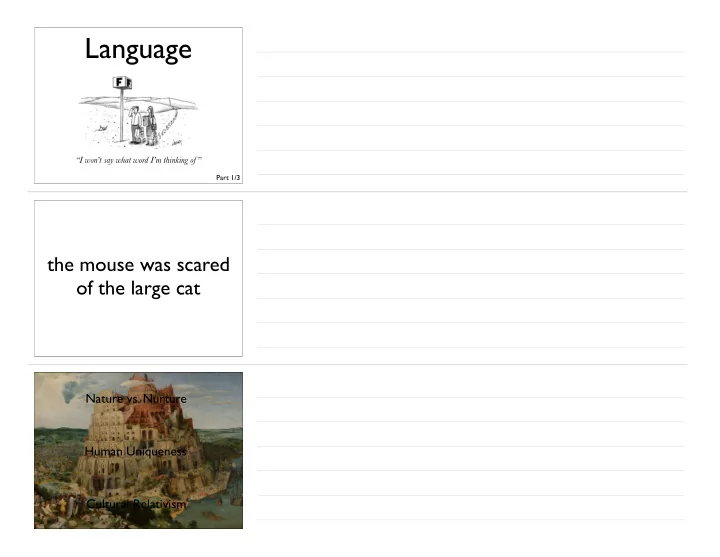

Language “I won’t say what word I’m thinking of” Part 1/3 the mouse was scared of the large cat Nature vs. Nurture Human Uniqueness Cultural Relativism
Questions + Themes How does language work ? Is language “ innate ”? Can other animals learn (human) languages? What is language?
What isn’t language? Some properties of language Rules not everything goes Arbitrariness no necessary connection between word & referent Displacement can refer to things that aren’t there Creativity produce & understand new sentences Infinity no limit to number and length of possible sentences our first exam better not be about how everyone was annoyed by the fact that Prof. Firestone spent way too much time discussing how I was upset when nobody believed me when I said that I read somewhere that the mouse was scared of the large cat
Language “I won’t say what word I’m thinking of” Part 2/3 Structure of Language Phonology ( ≈ sounds) Morphology ( ≈ words) Syntax ( ≈ grammar) Structure of Language Phonology ( ≈ sounds) Morphology ( ≈ words) Syntax ( ≈ grammar)
Structure of Language Phonology ( ≈ sounds) phoneme Structure of Language Phonology ( ≈ sounds) Phonology vs. Phonetics rules governing which sounds how speech sounds are are permissible/meaningful physically produced Structure of Language Phonology ( ≈ sounds) Word Boundaries “Wow, look at Jim’s plum pie!” “Wow, look at Jim’s plump eye!”
Structure of Language Phonology ( ≈ sounds) How Many Finnish Words? A. 4 B. 6 C. 8 D. 10 Structure of Language Phonology ( ≈ sounds) 4 Words Ilmatyynyalukseni on täynnä ankeriaita (“My hovercraft is full of eels”)
Structure of Language Phonology ( ≈ sounds) A Problem: Speech sounds are variable and ambiguous Structure of Language Phonology ( ≈ sounds) A Solution (one of many) : “top-down” processing Structure of Language Phonology ( ≈ sounds) “Legislature”
Structure of Language Phonology ( ≈ sounds) “Sinewave Speech” Structure of Language Phonology ( ≈ sounds) “McGurk Effect” Structure of Language Phonology ( ≈ sounds) For good?
Structure of Language Phonology ( ≈ sounds) Morphology ( ≈ words) Syntax ( ≈ grammar) Structure of Language Morphology ( ≈ words) faces morphemes
Structure of Language Phonology ( ≈ sounds) Morphology ( ≈ words) Syntax ( ≈ grammar) Structure of Language Syntax ( ≈ grammar) how words are combined into phrases & sentences Structure of Language Syntax ( ≈ grammar) mouse was cat of scared the large the
Structure of Language Syntax ( ≈ grammar) the mouse was scared of the large cat Structure of Language Syntax ( ≈ grammar) the mouse scared the large cat Structure of Language Syntax ( ≈ grammar) Chomsky: “Colorless green ideas sleep furiously”
Structure of Language Syntax ( ≈ grammar) Groucho Marx: “I once shot an elephant in my pajamas.” “How it got into my pajamas I’ll never know.” Shot [an elephant] [in my pajamas] Shot [an elephant in my pajamas] Structure of Language Syntax ( ≈ grammar) What language is vs Where language comes from
Language “I won’t say what word I’m thinking of” Part 3/3 “Man has an instinctive tendency to speak, as we see in the babble of our young children; whilst no child has an instinctive tendency to brew, bake, or write.” ( The Descent of Man , p.58) Innate? Innate ≈ Present at Birth Problem : this doesn’t happen
Analogy: Puberty Innate? Innate ≈ Present at Birth X Languages Language (English, French, German, Russian…) The capacity and inclination Innate? “No one would take seriously the proposal that the human organism learns through experience to have arms rather than wings, or that the basic structure of particular organs results from accidental experience. [Language] proves to be no less marvelous and intricate than these physical structures … Why, then, should we not study the Noam acquisition of a cognitive structure like language more or less as we study some Chomsky complex bodily organ?”
Some Facts About Language Every culture has it (with no exceptions) Every person has it (with telling exceptions) Automaticity XXXX “RED” XXXX “GREEN”
XXXX XXXX XXXX XXXX XXXX XXXX Red Green Blue Yellow Red Blue Red Green Blue Yellow Red Blue
Some Facts About Language Red Red Green Green “Stroop Effect” Blue Blue Automaticity Yellow Yellow Red Red Blue Blue Dissociations Broca’s Aphasia Content without fluency Wernicke’s Area damage damage Broca’s Area Wernicke’s Aphasia Fluency without content
Specific Language Impairment Williams Syndrome Prof. Barbara Landau Dept. of Cognitive Science
Creolization Pidgin (often lacks embedding, arbitrariness, etc.) Creole (a full-blown language) Learning vs. Teaching
Uniquely Human? A hypothesis with a checkered past… Tools Uniquely Human? Uniquely Human?
Uniquely Human? Aesthetics Uniquely Human? Bowerbirds “decorate” their homes Uniquely Human? Language?
Nim Chimpsky Typical chimpanzee utterances, after several years of training • Nim eat Nim eat Human children do much better • Drink eat me Nim • Nut Nim nut 100x larger vocabulary • Tickle me Nim play Not just concrete nouns and verbs • Grape eat Nim eat Grammatically complex sentences Know “more milk” > “milk more” • Eat Nim me • Eat me Nim • Me banana you banana me you give • Give orange me give eat orange me eat orange give me eat orange give me you
Why did we think otherwise? •Chimps are so smart! • But being smart isn’t enough. (Consider SLI) •Chimps are our nearest neighbors! • But still 5 million years of separation. •Language isn’t special; it’s like any other skill! • But it isn’t! Today’s Grand Ideas Human nature exists… we are not blank slates we are shaped by evolution, as any creature is …so do internal mental states we have thoughts and desires and goals, not just behaviors …& we can study both scientifically! just like we can study the internal states of computers
Recommend
More recommend